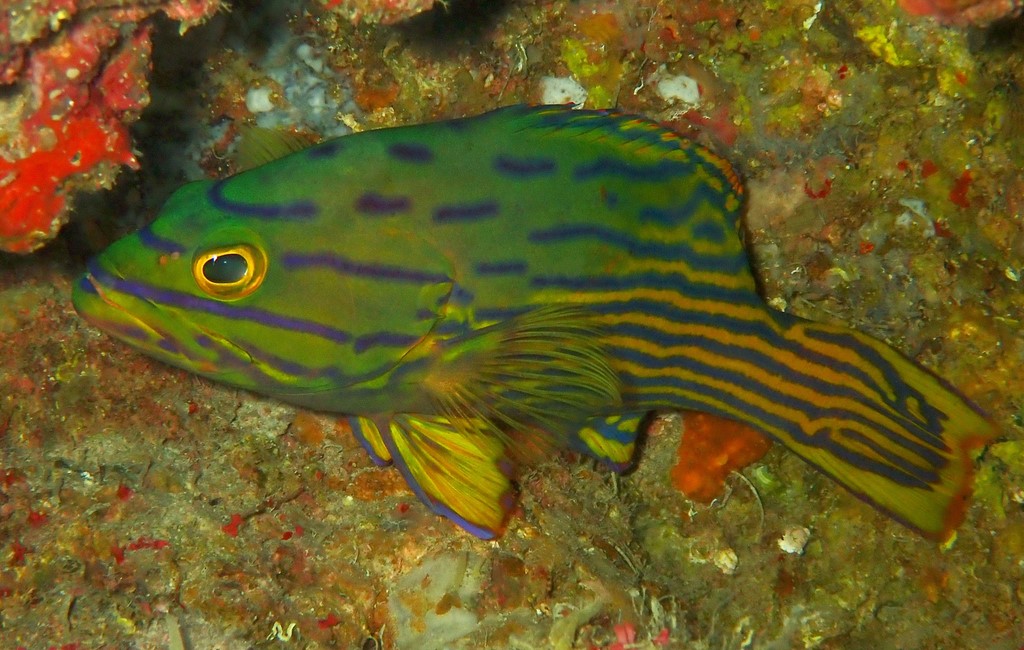CEPHALOPHOLIS POLLENI - (BLEEKER, 1868)
Picture courtesy of: Alain Daoulas
Actinopterygii (Gigaclass) > Actinopteri (Class) > Teleostei (Subclass) > Perciformes (Order) > Percoidei (Suborder) > Epinephelidae (Family) > Cephalopholis (Genus)
Actinopterygii (Gigaclass) > Actinopteri (Class) > Teleostei (Subclass) > Perciformes (Order) > Percoidei (Suborder) > Epinephelidae (Family) > Cephalopholis (Genus)
Vieille arlequin, Arlequin hind, Harlequin rockcod, Harlequin grouper, Blue-lined grouper, Garoupa arlequim, Cherna arlequín, Harlekyn-klipkabeljou, Minamihata, ミナミハタ, 卜氏九棘鱸, 多線纖齒鱸,
Synonymes
Aethaloperca polleni (Bleeker, 1868)
Cephalopholis virgatus (Fourmanoir, 1955)
Epinephelus polleni (Bleeker, 1868)
Gracila okinawae (Katayama, 1974)
Gracila polleni (Bleeker, 1868)
Gracilia polleni (Bleeker, 1868)
Plectropoma lineatum (Bliss, 1883)
----------------------
Description
Dorsal spines (total): 9 with the fin membrane distinctly indented between them; Dorsal soft rays (total): 14-16; Anal spines: 3; Anal soft rays: 8-9 (usually: 9); Pectoral fin rays: 17-19; Pectoral fins subequal to pelvic fins, pectoral-fin length contained: 1.5-1.9 times in head length; Caudal fin truncate to slightly emarginate. Lateral body scales ctenoid, without auxiliary scales; Lateral line scales: 66-72; Lateral scale series: 112-135. Body depth subequal to head length, depth contained: 2.7-3.1 times in standard length (for fish 9-26 cm standard length). Head long: 2.7-3.1 in SL. Eye diameter subequal to interorbital width and about twice depth of preorbital; Preopercle rounded, finely serrate, the lower edge with 1-3 broad serrae; Subopercle and interopercle finely serrate; Maxilla reaches about to vertical at rear edge of eye. Gill rakers: 7-8 on upper limb, 14-17 on lower limb. Max. length: 43.0 cm TL. Depth range: 10 - 120 m, usually: 30 - 120 m.
Aethaloperca polleni (Bleeker, 1868)
Cephalopholis virgatus (Fourmanoir, 1955)
Epinephelus polleni (Bleeker, 1868)
Gracila okinawae (Katayama, 1974)
Gracila polleni (Bleeker, 1868)
Gracilia polleni (Bleeker, 1868)
Plectropoma lineatum (Bliss, 1883)
----------------------
Description
Dorsal spines (total): 9 with the fin membrane distinctly indented between them; Dorsal soft rays (total): 14-16; Anal spines: 3; Anal soft rays: 8-9 (usually: 9); Pectoral fin rays: 17-19; Pectoral fins subequal to pelvic fins, pectoral-fin length contained: 1.5-1.9 times in head length; Caudal fin truncate to slightly emarginate. Lateral body scales ctenoid, without auxiliary scales; Lateral line scales: 66-72; Lateral scale series: 112-135. Body depth subequal to head length, depth contained: 2.7-3.1 times in standard length (for fish 9-26 cm standard length). Head long: 2.7-3.1 in SL. Eye diameter subequal to interorbital width and about twice depth of preorbital; Preopercle rounded, finely serrate, the lower edge with 1-3 broad serrae; Subopercle and interopercle finely serrate; Maxilla reaches about to vertical at rear edge of eye. Gill rakers: 7-8 on upper limb, 14-17 on lower limb. Max. length: 43.0 cm TL. Depth range: 10 - 120 m, usually: 30 - 120 m.
Color
- Adults mostly yellow (greenish or brownish yellow on head and anterodorsally on body in some fish), with 10-12 bright blue or violet horizontal stripes on body, the upper 2-3 broken into segments and extending posteriorly onto dorsal fin; The stripes running onto peduncle bifurcate and continue onto the caudal fin almost to the rear margin; Head with 3-6 horizontal blue stripes; Dark brown maxillary streak present; Pelvic fins yellow with blue stripes.
- Small juveniles (4 cm standard length) yellowish brown, shading to lavender ventrally and to yellow at base of caudal fin, the yellow continuing as a broad band in each caudal lobe; Snout yellow, with a large black spot on each side in front of nostrils.
- Larger juveniles (10 cm standard length) brownish orange with longitudinal purple stripes on head and body.
Etymology
Cephalopholis: from Greek, kephale = head + from Greek, pholis = scale. Referring to completely scaled head of Cephalopholis argus.
polleni: in honor of Dutch naturalist and merchant François Paul Louis Pollen (1842-1886), who collected type.
Original description: Epinephelus polleni Bleeker, 1868 - Type locality: Réunion island, western Mascarenes, southwestern Indian Ocean.
Distribution
Indo-West Pacific: Comoros, Madagascar and Mascarenes (La Réunion, Mauritius, Rodrigues) east to Line Islands and French Polynesia, north to Guam, south to Australia and New Caledonia.
Cephalopholis: from Greek, kephale = head + from Greek, pholis = scale. Referring to completely scaled head of Cephalopholis argus.
polleni: in honor of Dutch naturalist and merchant François Paul Louis Pollen (1842-1886), who collected type.
Original description: Epinephelus polleni Bleeker, 1868 - Type locality: Réunion island, western Mascarenes, southwestern Indian Ocean.
Distribution
Indo-West Pacific: Comoros, Madagascar and Mascarenes (La Réunion, Mauritius, Rodrigues) east to Line Islands and French Polynesia, north to Guam, south to Australia and New Caledonia.
Biology
Sporadic distribution. Occurs only at oceanic islands. Inhabits clear waters of steep drop-offs; Also found in caves and crevices. Often swims upside-down against the roofs of caves or archways. Feeds on fishes and crustaceans. Solitary.
Sporadic distribution. Occurs only at oceanic islands. Inhabits clear waters of steep drop-offs; Also found in caves and crevices. Often swims upside-down against the roofs of caves or archways. Feeds on fishes and crustaceans. Solitary.
Last update: 23, March 2024
